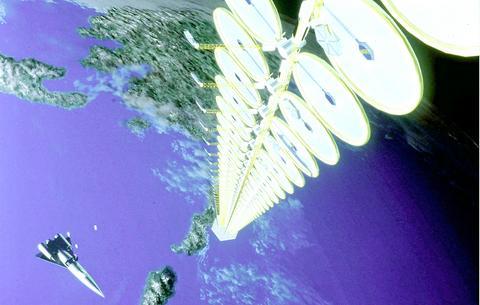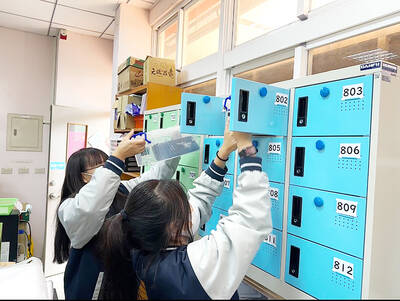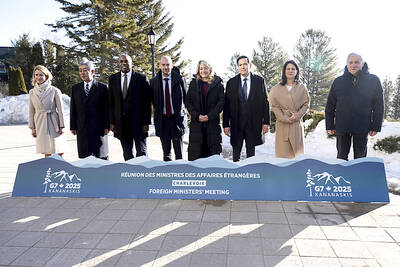Suppose that over the next decade or two the forecasts of global warming start to come true. Color has drained from New England's autumns as maple trees die, and the Baltimore oriole can no longer be found south of Buffalo, New York. The Dust Bowl has returned to the Great Plains, and Arctic ice is melting into open water. Upheavals in weather, the environment and life are accelerating around the world.
Then what?
If global warming occurs as predicted, there will be no easy way to turn the earth's thermostat back down. The best that most scientists would hope for would be to slow and then halt the warming, and that would require a top-to-bottom revamping of the world's energy systems, shifting from fossil fuels like coal, oil and natural gas to alternatives that in large part do not yet exist.

PHOTO: NY TIMES
"We have to face the fact this is an enormous challenge," said Martin Hoffert, a professor of physics at New York University.
But interviews with scientists, environment advocates and industry representatives show that there is no consensus on how to meet that challenge. Some look to the traditional renewable energy sources, solar and wind.
Others believe that use of fossil fuels will continue, but that the carbon dioxide can be captured and then stored underground.
The nuclear power industry hopes concern over global warming might help spur a commercial revival.
Hoffert and 17 other experts cited in the journal Science last November looked at alternatives to fossil fuels and found all to have "severe deficiencies in their ability to stabilize global climate."
The scientists said they believe that technological fixes are possible. Hoffert said the country needed to embark on an energy research program on the scale of the Manhattan Project that built the atomic bomb during World War II or the Apollo program that put men on the moon.
"Maybe six or seven of them operating simultaneously," he said of the research programs needed. "We should be prepared to invest several hundred billion dollars in the next 10 to 15 years."
But to have even a hope of finding a solution, the effort must begin now, the scientists said. It usually takes several decades to develop the underlying science for a new technology, build pilot projects and then begin commercial deployment.
The authors of the Science paper expect that a smorgasbord of energy sources will be needed, and they call for intensive research on radical ideas like vast solar arrays orbiting Earth that can collect sunlight and beam the energy down.
"Many concepts will fail, and staying the course will require leadership," they wrote. "Stabilizing climate is not easy."
Concentration
The heart of the problem is carbon dioxide, the main byproduct from the burning of fossil fuels. When the atmosphere is rich in carbon dioxide, heat is trapped, producing a greenhouse effect.
Most scientists believe the billions of tonnes of carbon dioxide released since the start of the Industrial Revolution are in part to blame for the 1?F rise in global temperatures over the past century. Carbon dioxide concentrations are now 30 percent higher than preindustrial levels.
With rising living standards in developing nations, emissions of carbon dioxide are increasing, and the pace of warming is expected to speed up, too.
Unchecked, carbon dioxide could reach twice preindustrial levels by midcentury and perhaps double again by the end of the century. That could force temperatures up by 2?F to 5?F by 2100, according to computer models.
Because carbon dioxide is colorless, odorless and disperses immediately into the air, few realize how much spills out of tailpipes and smokestacks. An automobile, for example, generates perhaps 50 to 100 tonnes of carbon dioxide in its lifetime.
The US produces more carbon dioxide than any other country by far. Each American, on average, generates about 20,400kg of carbon dioxide a year.
That is about twice as much as the average person living in Japan or Europe and many times more than someone living in a developing country like Zimbabwe, China or Panama.
Even if the US achieves President Bush's goal of an 18 percent reduction in the intensity of carbon dioxide emissions by 2012, the output of an average American would still far exceed that of almost anyone else in the world.
Even if all emissions stopped, levels of carbon dioxide in the air would remain high for centuries as the earth gradually absorbed the excess.
Currently, the world's energy use per second is about 12 trillion watts -- enough to light up 120 billion 100-watt bulbs -- and 85 percent of that comes from fossil fuels.
Of the remaining 15 percent, nuclear and hydroelectric power each supply about 6.5 percent. The renewable energy sources often touted as the hope for the future -- wind and solar -- provide less than 2 percent.
In March, Hoffert and two colleagues reported in Science that to limit the temperature increase to 3.6?F, energy sources that do not emit carbon dioxide would have to generate 7 trillion to 25 trillion watts by midcentury, an increase of four to 14 times as much as current levels. That is roughly equivalent to adding a large emission-free power plant every day for the next 50 years.
Energy Secretary Spencer Abraham cited the Science paper in a speech to the American Academy in Berlin two months ago. Abraham said that merely setting limits and timetables on carbon dioxide like those in the Kyoto Protocol could not by themselves solve global warming.
"We will also need to develop the revolutionary technologies that make these reductions happen," Abraham said. "That means creating the kinds of technologies that do not simply refine current energy systems, but actually transform the way we produce and consume energy."
Increased energy efficiency -- like better-insulated buildings, more efficient air conditioners, higher mileage cars -- is not a solution by itself, but it could buy more time to develop cleaner energy.
The much-talked-about hydrogen economy, in which gasoline-powered engines are replaced by fuel cells, is also not a solution. It merely shifts the question to what power source is used to produce the hydrogen.
Hydroelectric power has reached its limits in most parts of the world; there are no more rivers to dam.
Nuclear power is a proven technology able to generate large amounts of electricity, but before it could be expanded, the energy industry would have to overcome public fears that another accident, like those at Three Mile Island or Chernobyl, could occur. Solutions would also need to be found for safely disposing of radioactive spent fuel.
Marvin Fertel, senior vice president of the Nuclear Energy Institute, an industry group, said global warming had become such a worry that some environmental groups were becoming amenable to new nuclear plants.
"In private, that's what we get from them," he said.
In his Berlin speech, Abraham highlighted two projects the Energy Department was working on: carbon sequestration -- the capturing of carbon dioxide before it is emitted, and storing it underground -- and FutureGen, a US$1 billion prototype coal power plant that will produce few emissions. The plant will seek to demonstrate by 2020 how to convert coal to hydrogen on a commercial scale that would then be used to generate electricity in fuel cells or turbines. The waste carbon dioxide would be captured and stored.
Sequestration, however, will probably not be cost-effective for current power plants. The filters for capturing carbon dioxide from the exhaust gas would by themselves consume 20 percent to 30 percent of the power plant's electricity.
Renewing renewables
Solar energy is still a future promise. The cost of energy from solar cells has dropped sharply in the past few decades. One kilowatt-hour of electricity -- the energy to light a 100-watt bulb for 10 hours -- used to cost several dollars when produced by solar cells. Now it is only about US$0.35. With fossil fuels, a kilowatt-hour costs just a few cents.
But solar technology still has much room for improvement. Commercial cells are only 10 to 15 percent efficient. With more research, new strategies to absorb sunlight more efficiently could lead to cells that reached 50 percent to 60 percent efficiency. If the cells could be made cheaply enough, they could produce electricity for only US$0.01 or US$0.02 a kilowatt-hour.
Wind power is already practical in many places like Denmark, where 17 percent of the electricity comes from wind turbines. The newest turbines, with propellers as wide in diameter as a football field, produce energy at a cost of US$0.04 or US$0.05 a kilowatt-hour. Further refinements like lighter rotors could drop the price by another cent or two, making it directly competitive with the cost of natural gas.
Robert Thresher, director of the National Wind Technology Center at the National Renewable Energy Laboratory in Golden, Colorado, envisions large farms of wind turbines being built offshore.
"They would be out of sight," he said. "There's no shortage of space and wind."
Solar and wind power will be hampered because the sun doesn't always shine and the wind doesn't always blow. The current power grid is not well suited for intermittent power sources because the amount of power produced at any moment must match the amount being consumed. To exploit the sun and wind, utilities would have to develop devices that could act as giant batteries.
One concept is to pump compressed air into underground storage. When electricity is needed, the air would be released, turning a turbine to generate electricity.
The big ideas
Then there are the big ideas that could change everything. To get around the problem of the intermittency in solar power, solar arrays could be placed where the sun shines 24 hours a day -- in space. The power could be beamed to the ground via microwaves.
Another big idea comes from Klaus Lackner, a professor of geophysics at Columbia University: What if carbon dioxide could be scrubbed out of the air? His back-of-the-envelope calculations indicate it may be feasible, although he is far from being ready to demonstrate how.
But if that were possible, it would eliminate the need to shift from gasoline to hydrogen for cars. That would save the time and cost of building pipelines for shipping hydrogen, and gasoline is in many ways superior to hydrogen, which needs to be stored under very high pressure or at very cold temperatures.
Eventually, the captured carbon dioxide could be processed to create an artificial gasoline, Lackner said.
"Carbon may actually be just as clean, just as renewable," he said.

NATIONAL SECURITY: The Chinese influencer shared multiple videos on social media in which she claimed Taiwan is a part of China and supported its annexation Freedom of speech does not allow comments by Chinese residents in Taiwan that compromise national security or social stability, the nation’s top officials said yesterday, after the National Immigration Agency (NIA) revoked the residency permit of a Chinese influencer who published videos advocating China annexing Taiwan by force. Taiwan welcomes all foreigners to settle here and make families so long as they “love the land and people of Taiwan,” Premier Cho Jung-tai (卓榮泰) told lawmakers during a plenary session at the Legislative Yuan in Taipei. The public power of the government must be asserted when necessary and the Ministry of

Proposed amendments would forbid the use of all personal electronic devices during school hours in high schools and below, starting from the next school year in August, the Ministry of Education said on Monday. The Regulations on the Use of Mobile Devices at Educational Facilities up to High Schools (高級中等以下學校校園行動載具使用原則) state that mobile devices — defined as mobile phones, laptops, tablets, smartwatches or other wearables — should be turned off at school. The changes would stipulate that use of such devices during class is forbidden, and the devices should be handed to a teacher or the school for safekeeping. The amendments also say

EMBRACING TAIWAN: US lawmakers have introduced an act aiming to replace the use of ‘Chinese Taipei’ with ‘Taiwan’ across all Washington’s federal agencies A group of US House of Representatives lawmakers has introduced legislation to replace the term “Chinese Taipei” with “Taiwan” across all federal agencies. US Representative Byron Donalds announced the introduction of the “America supports Taiwan act,” which would mandate federal agencies adopt “Taiwan” in place of “Chinese Taipei,” a news release on his page on the US House of Representatives’ Web site said. US representatives Mike Collins, Barry Moore and Tom Tiffany are cosponsors of the legislation, US political newspaper The Hill reported yesterday. “The legislation is a push to normalize the position of Taiwan as an autonomous country, although the official US

CHANGE OF TONE: G7 foreign ministers dropped past reassurances that there is no change in the position of the G7 members on Taiwan, including ‘one China’ policies G7 foreign ministers on Friday took a tough stance on China, stepping up their language on Taiwan and omitting some conciliatory references from past statements, including to “one China” policies. A statement by ministers meeting in Canada mirrored last month’s Japan-US statement in condemning “coercion” toward Taiwan. Compared with a G7 foreign ministers’ statement in November last year, the statement added members’ concerns over China’s nuclear buildup, although it omitted references to their concerns about Beijing’s human rights abuses in Xinjiang, Tibet and Hong Kong. Also missing were references stressing the desire for “constructive and stable relations with China” and